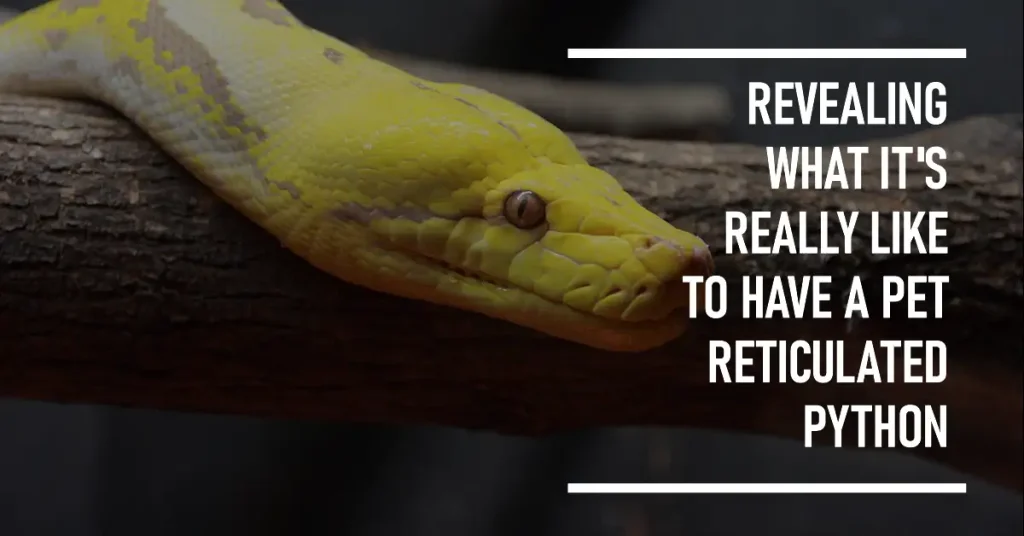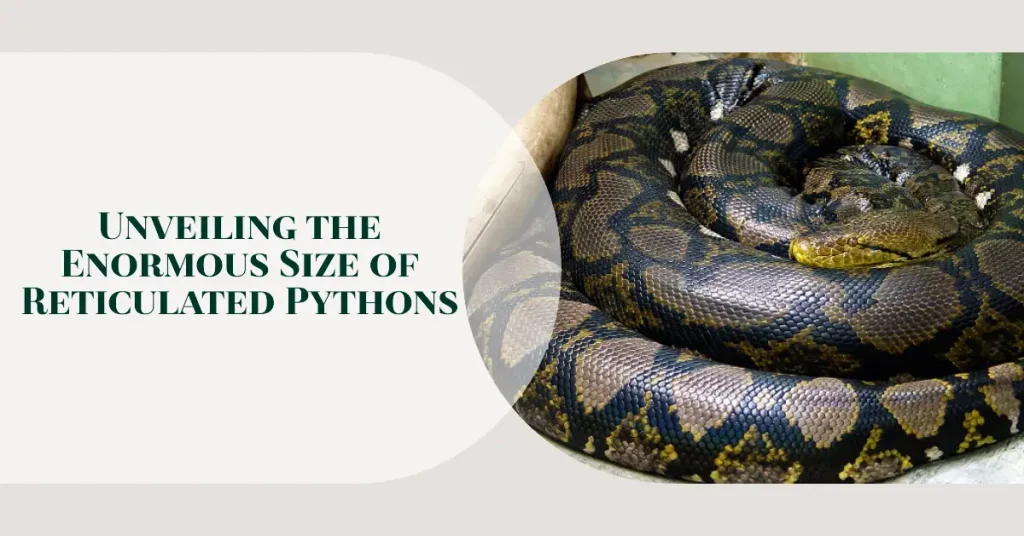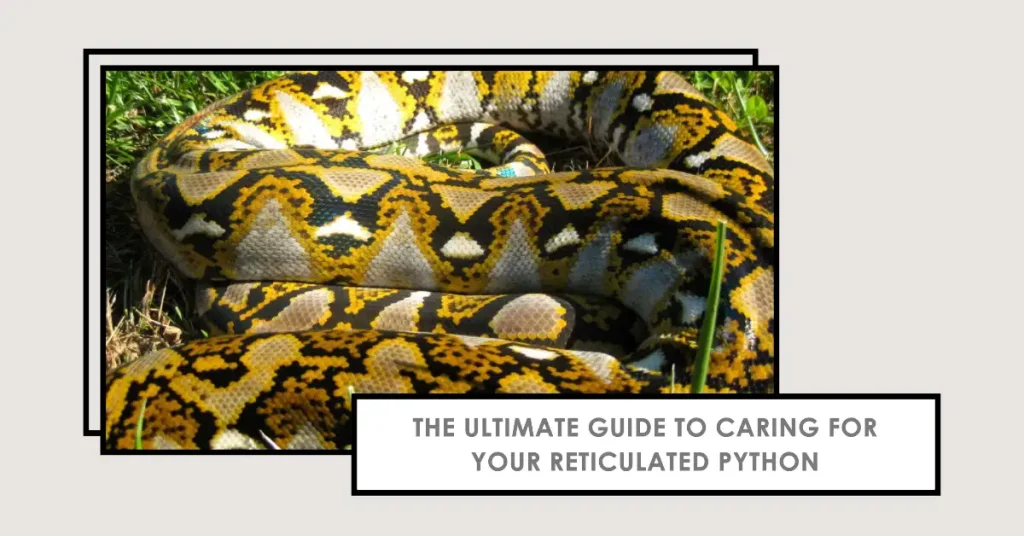Are you considering a reticulated python as a pet? As an experienced pet owner, I can attest to the unique joys and challenges of keeping these magnificent creatures. Reticulated pythons are the longest snakes in the world, reaching lengths of up to 30 feet. While they require specialized care and attention, they can make fascinating, affectionate, and surprisingly gentle companions.
Key Takeaways:
- Reticulated pythons can make friendly and fascinating pets.
- Proper care and attention are essential to keeping reticulated pythons healthy and happy.
- Potential owners should consider the unique challenges and benefits of keeping a reticulated python as a pet.
Reticulated Python Care: Providing the Perfect Environment
When it comes to caring for a reticulated python, creating a suitable environment is crucial for their health and wellbeing. As a responsible pet owner, it is essential to understand their specific requirements and follow proper care guidelines to ensure their long-term happiness and longevity.
Reticulated Python Habitat Requirements
Reticulated pythons are native to Southeast Asia and require a warm and humid environment to thrive in captivity. You will need a suitable enclosure that replicates their natural habitat with an ambient temperature range of 80 to 90 degrees Fahrenheit, and a basking spot that can reach up to 95 degrees Fahrenheit.
The ideal humidity level should be around 50-60%, which can be maintained by misting the enclosure with water regularly. You can also include a large water bowl in the enclosure for your python to soak in and maintain their hydration levels.
Enclosure Setup
The size of the enclosure is crucial, as reticulated pythons can grow up to 20ft long. A baby python can start in a 40-gallon tank, but as they grow, you will need to upgrade to a larger enclosure. A suitable enclosure should be at least 8ft long, 4ft wide, and 4ft tall for an adult python.
As for the substrate, you can use coconut coir, cypress mulch, or newspaper. Ensure there are numerous hiding places, branches, and climbing opportunities for your python to explore to keep them mentally stimulated. Ensure the enclosure is secure with a locking top to prevent escape.
Temperature and Humidity Needs
It is crucial to monitor and maintain the temperature and humidity levels in your reticulated python’s enclosure to ensure they are healthy. Using a digital thermometer and hygrometer can help you keep track of the temperature and humidity levels.
You will need to provide a heat source, such as heat lamps or ceramic heat emitters, to maintain the proper temperature levels. Make sure to position heat sources at one end of the enclosure to create a temperature gradient that allows your python to regulate their body temperature.
As for humidity, misting the enclosure regularly and providing a large water bowl for your python to soak in will help maintain proper levels.
Overall, providing a suitable environment for your reticulated python is crucial to their health and wellbeing. Regular monitoring of their temperature and humidity levels, proper enclosure setup, and appropriate substrate will ensure a happy and healthy pet.
Understanding Reticulated Python Behavior
As a reticulated python owner, one of the most crucial aspects of caring for your pet is understanding their behavior. As with any living being, reticulated pythons have natural instincts and habits that are important to recognize and respect. Here are some key points to keep in mind:
Feeding Habits
Reticulated pythons are carnivores and feed primarily on small animals like rodents, birds, and other reptiles. They are ambush predators and typically eat their prey whole, which means that their meals must be appropriately sized to avoid choking or digestive issues.
It’s important to establish a regular feeding schedule to ensure that your python is getting the nutrition they need. While baby pythons may need to eat multiple times a week, adults may only need to eat every few weeks.
Natural Instincts
As predators, reticulated pythons have natural hunting instincts that can sometimes manifest in aggressive behavior towards humans. Even individuals that are well-socialized and accustomed to handling may exhibit defensive or territorial behavior if they feel threatened.
It’s essential to handle your python with confidence and respect, using appropriate techniques to minimize the risk of injury or stress. Avoid approaching them suddenly or unexpectedly, and never handle them when they are in the middle of shedding their skin or have recently eaten.
Handling Considerations
When handling a reticulated python, it’s important to prioritize safety for both yourself and your pet. Always support their weight properly, using both hands to avoid dropping them or causing them discomfort. If your python becomes agitated or nervous, gently return them to their enclosure and allow them to calm down on their own.
Remember that every python is different, and what works for one individual may not work for another. Pay attention to your pet’s body language and vocalizations, and be prepared to adjust your handling technique as needed to ensure their comfort and safety.
Size Matters: Growing Up with a Reticulated Python
One of the most striking features of reticulated pythons is their potential size. As hatchlings, these snakes are relatively small, ranging from 18 to 36 inches in length. However, as they mature, they can grow to be over 20 feet long and weigh up to 200 pounds!
It’s essential to consider the size of a reticulated python when deciding to bring one into your home. Not only do they require a significant amount of space to move and explore, but their enclosure must also be able to accommodate their size as they grow.
When setting up an enclosure for a reticulated python, it’s important to choose a size that will be suitable for the snake throughout its life. A commonly recommended minimum enclosure size for an adult reticulated python is 8 feet by 4 feet by 4 feet. However, many experts suggest larger enclosures, such as 10 feet by 5 feet by 6 feet, to provide ample space for the snake to move and climb.
It’s also important to consider the thickness and stability of the enclosure walls, given the potential strength of an adult reticulated python. A sturdy and escape-proof enclosure is crucial to ensure the safety of both the snake and its keeper.
Handling an Adult Reticulated Python
As reticulated pythons grow, their strength and size can present unique challenges during handling. Adult pythons require a firm and confident grip, with a minimum of two people to safely handle them.
It’s important to avoid restraining the snake too tightly, as this can cause stress and injury. Instead, support the weight of the snake with your hands and keep a firm grip on its body without squeezing too hard.
When interacting with an adult reticulated python, always be mindful of its size and strength. Avoid handling the snake alone, and never leave it unattended with children or pets.
Creating the Perfect Reticulated Python Habitat
Providing a suitable habitat for your reticulated python is crucial to its wellbeing. A comfortable and enriched living space can help prevent stress and promote natural behaviors. Here are some key considerations when setting up your python’s habitat:
Choosing the Right Substrate
The substrate is the material that lines the bottom of your python’s enclosure. Reticulated pythons require a substrate that is absorbent, easy to clean, and non-toxic. Aspen shavings, coconut coir, or cypress mulch are all suitable options. Avoid using substrates such as sand, gravel, or newspaper, which can be harmful or uncomfortable for your pet.
Providing Hiding Spots
Reticulated pythons are known for their love of hiding and feeling secure in tight spaces. Providing at least one or two hiding spots in the enclosure can help your pet feel safe and secure. You can use reptile caves, half logs, or even cardboard boxes as hiding spots.
Add Enrichment Opportunities
Enrichment is essential for keeping your pet active, curious, and mentally stimulated. Consider adding branches, artificial plants, and other objects that your pet can climb on or interact with. Additionally, you can provide puzzle feeders or hide food items around the enclosure to encourage natural foraging behaviors.
Separate Feeding and Basking Areas
Reticulated pythons require a basking spot with a temperature range of 90 to 95°F (32 to 35°C). It’s important to separate the basking area from the feeding area, as pythons can become stressed or aggressive if they associate their feeding spot with other activities. You can use a heat lamp or heating pad to provide a basking area and monitor the temperature with a thermometer.
Remember to clean your python’s enclosure regularly and provide fresh water at all times. With the right habitat setup, your reticulated python can thrive and enjoy a comfortable home.
A Healthy Diet: Feeding Your Reticulated Python
Feeding a reticulated python can be a daunting experience for some pet owners, but with the right knowledge and approach, it can be a rewarding part of your pet’s care routine.
Understanding Dietary Needs
Reticulated pythons are carnivorous and typically feed on a variety of prey items, including rodents, birds, rabbits, and other small mammals. As they grow, they will require larger and more substantial meals to maintain their health and energy levels.
Establishing a Feeding Schedule
It’s important to establish a regular feeding schedule for your reticulated python, as this will help regulate their digestive system and ensure they are receiving adequate nutrition. Typically, young pythons may need to be fed more frequently, while adults can go longer between meals.
Choosing the Right Prey Items
When selecting prey items for your reticulated python, it’s important to choose high-quality sources that are appropriate for their size and nutritional needs. Frozen-thawed prey items are recommended, as they are safer and more convenient than live prey.
| Prey Item | Frequency |
|---|---|
| Small rodents (e.g. mice, rats) | Weekly for young pythons; every 2-3 weeks for adults |
| Large rodents (e.g. rabbits, guinea pigs) | Every 2-4 weeks for young pythons; every 4-6 weeks for adults |
| Birds (e.g. quail, chicks) | Every 2-4 weeks for young pythons; every 4-6 weeks for adults |
Feeding Techniques and Precautions
When feeding your reticulated python, it’s important to be cautious and maintain a safe distance from their mouth to prevent accidental bites. Always use feeding tongs or other tools to offer prey items, and avoid handling your python for at least 24 hours after feeding to allow for proper digestion.
With proper care and attention, feeding your reticulated python can be a rewarding experience that strengthens the bond between you and your incredible pet.
The Right Enclosure: Housing Your Reticulated Python
Proper housing is crucial for the health and well-being of your reticulated python. When selecting an enclosure, consider the size of your snake and provide ample space for movement and growth. A general rule of thumb is to provide a minimum of 1.5 times the length of your snake in enclosure length, and at least half of the enclosure height as climbing space.
Enclosure material can range from glass to PVC, with both having their advantages and disadvantages. Glass enclosures may offer better visibility but are heavier and harder to maintain temperature and humidity levels. PVC enclosures are lighter and easier to maintain, but may not offer the same viewing experience.
When setting up the enclosure, provide a substrate that allows for easy cleaning and good hygiene. Newspaper, paper towels, and reptile carpet are all good options. Provide hiding spots and climbing opportunities, such as logs or branches. Ensure that the enclosure has proper ventilation, and maintain a consistent temperature and humidity range of 80-85°F and 50-60%, respectively.
Remember to regularly clean and disinfect the enclosure to prevent the buildup of harmful bacteria or fungi. Always handle your snake with care when cleaning the enclosure, and avoid using harsh chemicals or cleaners that can be harmful to your pet.
Overcoming Challenges: Common Issues with Reticulated Pythons
As with any pet, owning a reticulated python comes with its own set of challenges. Here are some common issues that you may face:
Aggressive Behavior
It’s important to note that reticulated pythons are not naturally aggressive towards humans, but they may become defensive if they feel threatened or stressed. Avoid handling your snake excessively or when it’s shedding, and ensure that its enclosure is big enough to provide adequate space to move around.
Health Issues
Like all animals, reticulated pythons can suffer from a variety of health issues, including respiratory infections, mites, and mouth rot. It’s essential to monitor your snake’s health, including its appetite, appearance, and behavior, and seek veterinary care immediately if you notice any signs of illness.
Escape Attempts
Reticulated pythons are powerful and agile creatures, and they may attempt to escape from their enclosure if it’s not secure enough. Ensure that all openings are tightly sealed and that the lid is firmly in place. Regularly check for signs of wear and tear on the enclosure and its components, like locks and latches.
Habitat Maintenance
Keeping your snake’s enclosure clean and tidy is crucial for its health and happiness. Spot clean daily and perform a deeper clean weekly or bi-weekly, depending on the size of the enclosure and the number of snakes you have. Remove any uneaten prey items, feces, and shed skin promptly, and disinfect the enclosure as needed.
Handling Tips: Interacting Safely with Your Reticulated Python
Handling a reticulated python requires proper technique and confidence. Remember, they are powerful animals and can sense fear and uncertainty in their handlers. Here are some tips to keep in mind when interacting with your pet:
- Approach with confidence: Approach your reticulated python with confidence, as they can sense fear and hesitancy.
- Position yourself correctly: Always make sure you have a good grip and a secure hold on your python. Support their entire body, including their head.
- Be aware of their body language: Pay attention to your python’s body language to avoid startling them. Signs of agitation include hissing, rearing up, or striking.
- Start handling early: Get your reticulated python used to being handled when they’re young. Gradually increase the amount of time you spend handling them, and always supervise children when they are interacting with the snake.
- Practice regular health checks: Regularly check for any injuries or health issues on your python’s body, especially when handling. If you notice anything unusual, consult with a veterinarian immediately.
Remember to respect your reticulated python’s nature and personality. Every snake is different and may have individual quirks and preferences. Take the time to get to know your pet and build a trusting relationship for safe and enjoyable interactions.
The Benefits of Owning a Reticulated Python as a Pet
As someone who has experience owning a reticulated python, I can confidently say that these incredible creatures make wonderful pets for the right person. Here are a few of the benefits of owning a reticulated python:
- Beauty: Reticulated pythons are stunning creatures, with intricate patterns and a sleek, impressive look.
- Low maintenance: Compared to traditional pets like dogs or cats, reticulated pythons require relatively little maintenance once their habitat is set up properly.
- Long lifespan: With proper care, reticulated pythons can live for decades, making them a long-term companion.
- Unique bond: While they may not be as demonstrative as some pets, reticulated pythons can form a unique bond with their owners through calm interaction and handling.
Of course, owning a reticulated python is not for everyone. It requires a significant level of commitment and responsibility, and there are important ethical considerations to take into account. However, for those who are willing to invest the time, effort, and resources required, a reticulated python can be a truly rewarding and fascinating pet.
Considering a Reticulated Python? Think Twice.
While reticulated pythons can make fascinating and rewarding pets, it’s important to carefully consider the commitment and responsibility involved. Before getting a reticulated python, I recommend taking the following factors into account:
- Size and Space: Reticulated pythons can grow up to 20 feet long and require a significant amount of space as they mature. Ensure that you have adequate room for an appropriately-sized enclosure and consider whether you are prepared to handle a large and potentially heavy animal.
- Legal Restrictions: Some states and localities have specific laws regarding owning exotic pets, including reticulated pythons. Be aware of any regulations that may apply to your area before bringing a python home.
- Time and Attention: While reticulated pythons are low maintenance compared to some other pets, they still require daily attention and care. Ensure that you are willing and able to provide a suitable habitat, regular feeding, and routine health checks.
- Financial Responsibility: The cost of owning a reticulated python goes beyond just the upfront expense of purchasing the animal and setting up its enclosure. Be prepared to budget for ongoing expenses such as food, substrate, and veterinary care.
- Respect and Safety: Reticulated pythons are powerful animals that require proper handling and respect. Consider whether you are comfortable interacting with a large and potentially dangerous animal, and ensure that you are sufficiently educated on proper handling techniques.
- Ethical Considerations: The decision to own a reticulated python should not be taken lightly. Consider the impact of removing a wild animal from its natural habitat, and ensure that you are obtaining your python from a reputable source that practices ethical breeding and care practices.
By carefully weighing these factors and doing your research, you can make an informed decision about whether a reticulated python is the right pet for you. While these snakes can be fascinating and rewarding companions, they are not suitable for everyone and require a significant commitment of time, space, and resources.
Conclusion
In conclusion, owning a reticulated python can be a rewarding and fulfilling experience for the right person. These snakes are fascinating creatures with a lot of personality, and they can make for loyal and friendly companions. However, it is important to remember that they are not suitable pets for everyone, and prospective owners should carefully consider their ability to provide for the python’s needs before making a commitment.
Throughout this article, we have discussed the various aspects of caring for a reticulated python, including their habitat, behavior, diet, and potential challenges. By following the guidance provided and doing your research, you can provide a safe and comfortable home for your python while developing a strong bond with your scaly friend.
It is important to keep in mind that owning a reticulated python requires a significant amount of time, effort, and financial investment, and it is not a decision to be taken lightly. Additionally, some jurisdictions may have legal restrictions on owning these snakes, and ethical considerations should always be taken into account.
Ultimately, the decision to own a reticulated python as a pet should be made after careful consideration and preparation. If you are willing and able to provide for the python’s needs, owning one can be a truly rewarding experience that will bring you closer to these amazing creatures in ways you never imagined.
FAQ
Q: Can a reticulated python be kept as a pet?
A: Yes, reticulated pythons can be kept as pets, but they require specific care and habitat conditions.
Q: What do reticulated pythons need in terms of care?
A: Reticulated pythons need a proper habitat setup, including the right enclosure, temperature, humidity, and feeding schedule.
Q: How do reticulated pythons behave?
A: Reticulated pythons have natural instincts and feeding habits, and they need to be handled with care.
Q: How big do reticulated pythons grow?
A: Reticulated pythons can grow to be very large, and their size needs to be accommodated as they mature.
Q: What is required to create the perfect habitat for a reticulated python?
A: Crafting the perfect habitat involves choosing the right substrate, providing hiding spots, and offering enrichment opportunities.
Q: What is the diet of a reticulated python?
A: Reticulated pythons require a healthy diet consisting of appropriate prey items and a suitable feeding schedule.
Q: How should a reticulated python be housed?
A: It’s important to select and maintain a suitable enclosure for a reticulated python, considering their safety, space requirements, and ventilation needs.
Q: What are some common challenges with reticulated pythons?
A: Owners may face challenges such as aggressive behavior, health issues, and potential escape attempts.
Q: How can a reticulated python be safely handled?
A: Handling a reticulated python requires proper technique, confidence, and respect for the snake’s needs and behavior.
Q: What are the benefits of owning a reticulated python as a pet?
A: Owning a reticulated python can offer benefits such as their beauty, low maintenance requirements, and the unique bond that can be formed.
Q: What considerations should be taken into account before getting a reticulated python?
A: Potential owners should consider the commitment required, legal restrictions, and ethical considerations before acquiring a reticulated python.
Featured image: Keith Pomakis, CC BY-SA 3.0, via Wikimedia Commons


